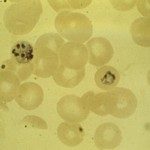Link to Pubmed [PMID] – 4524649
Proc Natl Acad Sci U S A 1974 Apr; 71(4): 1466-70
The synthesis of poly(A)-containing cytoplasmic RNA was examined in primary myoblast cultures prepared from skeletal muscle of fetal calves. After a period of cell division, these cells undergo fusion, with concomitant appearance of acetylcholine receptor and subsequent myosin synthesis. In the dividing myoblast there is a high level of messenger RNA synthesis, including a 26S RNA, the size of a putative messenger for the large subunit of myosin. In the transition period prior to fusion, there are quantitative changes in RNA synthesis. At this time, there is a pronounced production of 26S RNA, which diminishes during fusion. The possibility that 26S RNA is accumulated in the dividing myoblast was investigated by chase experiments. At fusion, there is a marked increase in the half-lives of a number of messenger RNA species, including 26 S, which increases from about 10 hr in the dividing cell to a value of more than 50 hr. The identity of the more rapidly turning over 26 S in the myoblasts, compared to that of the 26 S at fusion, was examined in terms of polysomal distribution, migration on gels, and hybridization with complementary DNA for the myosin message. The results of these analyses suggest that the 26S species are identical. Thus, it would appear that in a predetermined cell like the myoblast, the transition to the differentiated state of myotube that is synthesizing muscle specific proteins is effected by the stabilization of messenger already being actively transcribed: terminal differentiation, with respect to myosin synthesis, is preceded by the stabilization of 26S RNA.

